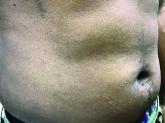News

Flat-topped papules on the neck, arms, and trunk
- Author:
- Miriam Swartz
- Lucy L. Chen, MD
- Diane Walder, MD
- Caroline Y.Winslow, MD
Publish date: June 12, 2020
A 29-year-old male presented with multiple 1-mm flat-topped papules on his neck, arms, and trunk.
